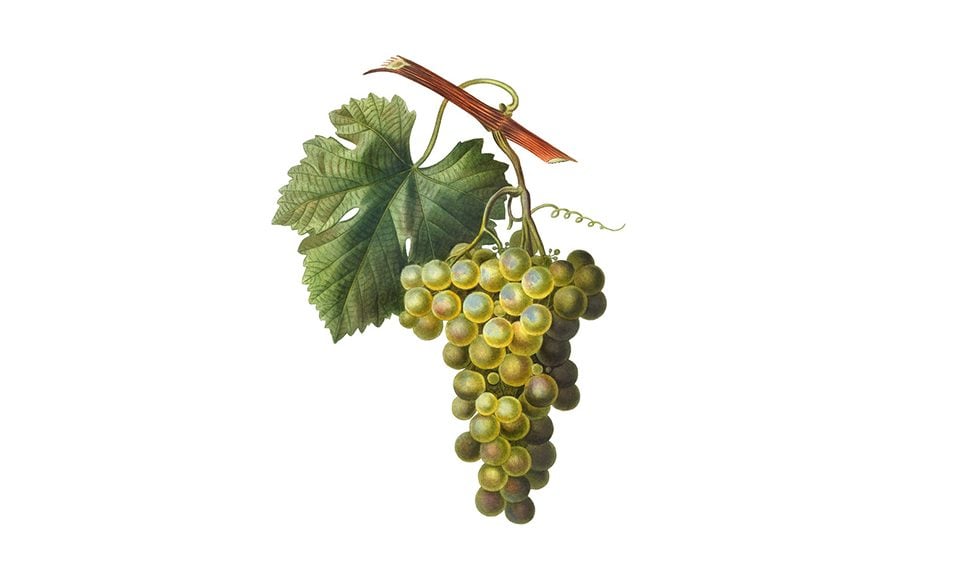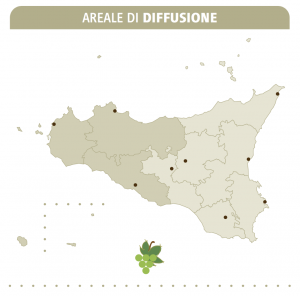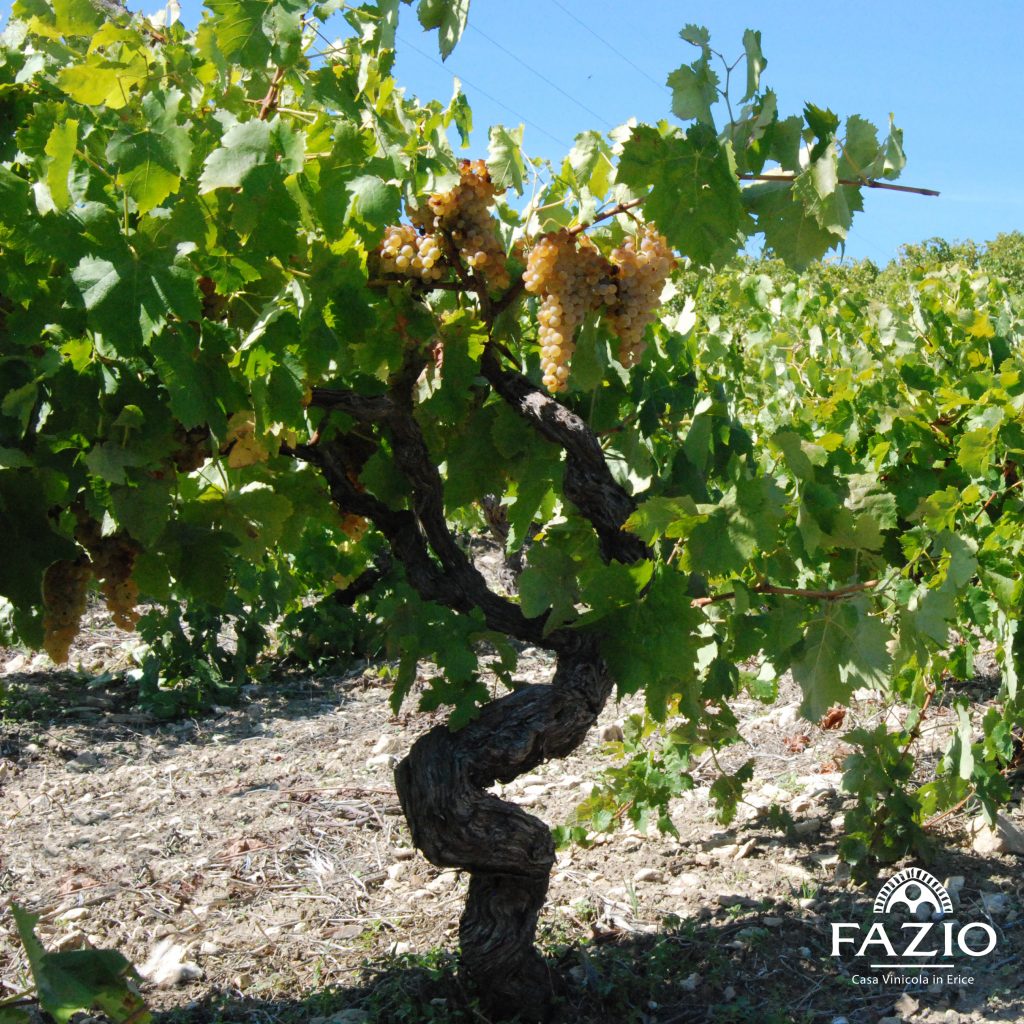Synonyms: Catarratto; Catarratto Latino; Catarratteddu; Catarrattulu Nostru; Catarratto Amantiddatu, Catarratto Lustru, Catarratto Virdulicchiu, Catarratto Dattuliddu.
The Catarratto comune is a variety long cultivated on the island. To repeat an affirmation of Count Gallesio (1937-1939): “it is to be considered a classic grape variety of Sicily”. Biundi (1852) wrote: “it should be said that there are no vineyards in Sicily in which Catarratto is not one of the most planted vines”. It is cited in the writings of Venuti (1516) and of the prefect of the city of Noto (1877). Cupanis, in his Hortus Catholicus of 1696, distinguishes a Catarrattu Vrancu(white) from a Catarratto Reusoor Reticu, which some writers have associated with the uva retica described by Pliny the Elder. Canon Geremia, in his work Statulegrafia etnea, draws the etymology of the word from “ruo”, to wither or lose flowers, alluding, therefore, to an agronomical characteristic of one type of Catarratto, the bagascedda, which is indicated by other writers as tirichitior trichititi, confusing it, however, with the “Corinto” grape. Both in the Universal Ampelography of Di Rovesenda, and in Le Vignoble (1874-1875), Pulliat and Mas indicate two types of Catarratto. Mendola, in 1883, considers Catarratto a tribe composed of at least five varieties: Catarratto Bianco Comune (or common, the progenitor); Catarrato Reuso or Femminedda or Bagascedda; Catarratto Mantellato or, in the province of Agrigento,alla Porta; Catarratto Bertolaro (Bertola, in Sicilian dialect means “saddle bag”); and Catarratto Nero, known as Mainone in the province of Agrigento and in Cagnolone in Sicily, by some erroneously confused with Montonico Nero.
The Catarratto Mantellato or Alla Porta is described, together with the Catarratto Bianco Comune, by Viala and Vermorel (1801-1810), where it is noted that in the province of Syracuse it is known as Catarratto Scalugnatu or Scarugnatu because, in certain vintages, it suffers from colure and from damage from mould or rot. In the “Catalogue of Varieties Cultivated in the province of Palermo” (1883), eight types of Catarratto are mentioned. In the ampelographic collection of Mendola and Di Rovesanda, a Catarratto Bianco carusowas also present, as was the Catarratto Moscato Cerletti obtained from Mendola’s crossing of Catarratto Bianco Comune and Zibibbo.
Today, the National Registry of Grape Varieties lists two Catarratto, the Bianco Comune (code number 058) and the Bianco Lucido (code number 059). Recent molecular biology research (Di Vecchi Staraz et al., 2007) has demonstrated that there are two bio-types of a single variety. In addition, Di Vecchi Staraz et al. (l.c) and Crespan et al. (2008) have shown that Catarratto is a parent of such an important Italian variety as Garganega, considered one of the oldest Italian grapes of all, and therefore the Sicilian variety is related to Albana, the Dorona of Venice, Mantonico Bianco, Malvasia di Candia, Marzemina Bianca, Mostosa, Trebbiano Toscano, and Susamaniello. Finally, the same authors have noted that Catarratto Bianco and Zibibbo (Moscato di Alessandria) are the parents of another important Marsala grape: Grillo.
The Catarratto comune is, by a large margin, the most important Sicilian grape of all, intensely planted in the provinces of Trapani, Palermo, and Agrigento and, in any case present, in all of the island’s provinces. This variety is part of the various appellation wines of Sicily’s center-west and, as well, in a number of major appellations of eastern Sicily. The various types of Catarratto were of predominant importance in the Marsala area during the second half of the 19th century, but suffered a certain contraction of their vineyard surface in favour of Grillo (which is particularly suitable for the production of Marsala), but recovered this loss during the second half of the century. Today, thanks as well to a revaluation of its oenological potential, it is once again in a phase of expansion in the entire territory of the island.
Catarratto, as already said, though showing one sole microsatellite profile (SSR Single Sequence Repeats), presents a very large infra-varietal variability of its phenotypes, as demonstrated by the inscription in the National Register of Grape Varieties of two distinct types: Catarratto Bianco Comune and Catarratto Bianco Lucido. An evaluation of the phenotypes has assisted in the characterization of two bio-types, which differ both in terms of the morphology of their bunches and of the quality of the grapes. The two bio-types are called A, the ideal type of Catarratto Comune Bianco, and B, which represents the bio-type commonly known as Caratteddru.
The beginning of the ripening, which can be considered in an average period, coincides with the first part of the month of August and proceeds in particularly regular manner both in terms of the accumulation of sugar and the evolution of the acidity. The two bio-types show a different capacity of sugar accumulation, already in evidence during the first moments of their ripening, but the same cannot be said of the maturation of the acidity, which is identical in the two bio-types. This process is stable in the case of the acidity, but the accumulation of sugar is strongly influenced by the growing season. At the moment of the picking, the must shows average sugar levels and high levels of measurable acidity.
The musts, at harvest time, show an average level of sugar, while the acidity is medium to high with a prevalence of tartaric acid over the malic; the balance between sugar and acidity is excellent, particularly in the case of bio-type A, which presents slightly lower sugar level. The level of assimilable nitrogen is considered superior in the case of both bio-types, while the level of potassium is an average.
Sensorial profile: the wine is a straw yellow in color with greenish highlights, the aromas are complex and of good intensity, characterized by floral and fruity notes, the latter both tropical and citric, and of spices. The two bio-types differ in their sensorial profile: in Catarratteddru the herbaceous notes dominate, while the profile of Catarratto Comune is characterized by notes of fruit, citric sensations, and by a greater persistence. On the palate, Catarratto wines, particularly those produced from bio-type A, show a good structure and an elevated aromatic persistence, while those made from bio-type B are more intensely alcoholic and show a more perceptible bitter note on the finish.
Sources: Identità e Ricchezza del Vigneto Sicilia / A cura di Giacomo Ansaldi Dario Cartabellotta Vito Falco Francesco Gagliano Attilio Scienza / Assessorato Regionale dell’Agricoltura, dello Sviluppo Rurale e della Pesca Mediterranea, Dipartimento Regionale dell’Agricoltura, VI Servizio Assistenza Tecnica in Agricoltura, Programmazione e Sistemi Informativi.






